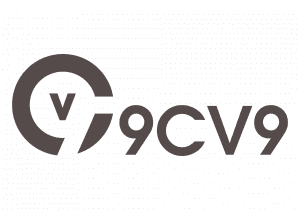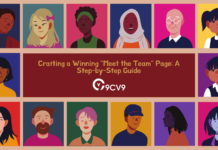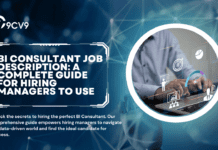Key Takeaways
- A job description defines roles, responsibilities, and expectations, helping employers attract and retain the right talent.
- Well-structured job descriptions improve recruitment, employee performance, and workforce alignment.
- Following best practices ensures job descriptions stay clear, engaging, and relevant for today’s dynamic workplace.
In today’s competitive job market, crafting the right job description has become more than just an administrative task—it is a strategic cornerstone of successful hiring and workforce management. A job description is often the first interaction potential candidates have with an organization, shaping their perception of the role, the company culture, and their future career path. Without a clear and well-structured job description, businesses risk attracting unqualified applicants, facing high turnover rates, or creating role confusion that ultimately affects productivity and employee satisfaction.

So, what exactly is a job description, and why does it hold so much weight in modern recruitment and talent management? At its core, a job description is a detailed document that outlines the responsibilities, duties, qualifications, and expectations associated with a particular role. But beyond being a list of tasks, it serves as a vital communication tool between employers and employees. It defines not only what is required but also why the role exists, how it contributes to organizational goals, and what success looks like in that position.
For employers, a well-written job description streamlines the recruitment process by setting precise expectations and helping recruiters target the right talent pool. It also plays an essential role in compliance and performance management, ensuring fairness, transparency, and alignment with labor laws and industry standards. For candidates, job descriptions provide clarity on whether they are suited for the role, what skills are required, and how the position fits into their career aspirations.
The importance of job descriptions has grown significantly in recent years with the rise of remote work, evolving workplace dynamics, and the increasing emphasis on skills over traditional credentials. In 2025 and beyond, organizations must view job descriptions not as static documents but as living resources that evolve alongside company goals, industry trends, and employee expectations. Clear, inclusive, and engaging job descriptions not only attract high-quality candidates but also strengthen employer branding and enhance employee retention.
In this blog, we will explore the definition of a job description, its core purpose, the essential elements it should include, and the best practices to follow when writing one. We will also highlight common mistakes to avoid and provide actionable insights on how to keep job descriptions relevant in a rapidly changing workplace. Whether you are an HR professional, a hiring manager, or a business owner, understanding the true value of a job description is the first step toward building stronger teams and driving long-term organizational success.
Before we venture further into this article, we would like to share who we are and what we do.
About 9cv9
9cv9 is a business tech startup based in Singapore and Asia, with a strong presence all over the world.
With over nine years of startup and business experience, and being highly involved in connecting with thousands of companies and startups, the 9cv9 team has listed some important learning points in this overview of What is a Job Description? Definition, Purpose, and Best Practices.
If your company needs recruitment and headhunting services to hire top-quality employees, you can use 9cv9 headhunting and recruitment services to hire top talents and candidates. Find out more here, or send over an email to [email protected].
Or just post 1 free job posting here at 9cv9 Hiring Portal in under 10 minutes.
What is a Job Description? Definition, Purpose, and Best Practices
- What is a Job Description?
- Purpose of a Job Description
- Key Components of a Job Description
- Benefits of a Well-Written Job Description
- Best Practices for Writing Job Descriptions
- Common Mistakes to Avoid
- Examples of Effective Job Descriptions
- How to Keep Job Descriptions Relevant in 2025 and Beyond
1. What is a Job Description?
A job description (JD) is a formal document that defines the roles, responsibilities, qualifications, and expectations for a specific job within an organization. It acts as both a recruitment tool and a performance management framework, ensuring clarity for employers and employees alike.
Core Definition
- A job description is a written statement outlining the purpose of the role, primary tasks, required skills, reporting structure, and working conditions.
- It serves as a contractual and informational guide, helping align candidate expectations with organizational needs.
- It is different from but closely related to:
- Job Specification → Focuses on the skills, qualifications, and experience required.
- Job Role → Refers to the function an employee performs within the organization.
Main Functions of a Job Description
- Recruitment & Selection
- Attracts qualified candidates by clearly stating requirements.
- Serves as a benchmark during interviews.
- Employee Guidance
- Sets clear expectations for performance and responsibilities.
- Provides direction on day-to-day activities.
- Legal & Compliance
- Ensures compliance with labor laws and organizational policies.
- Helps prevent disputes regarding role boundaries.
- Performance Management
- Basis for setting KPIs and performance reviews.
- Assists in identifying training and development needs.
Key Elements of a Job Description
A typical job description contains several core sections, which can be represented as follows:
| Section | Details | Example |
|---|---|---|
| Job Title | Clear and specific; reflects the role and level. | Marketing Manager, Software Engineer, HR Specialist |
| Job Summary | Short overview of the role’s purpose and impact. | “Responsible for planning and executing digital campaigns to drive brand growth.” |
| Duties & Responsibilities | List of core tasks and expectations. | “Develop SEO strategies, manage content calendars, oversee PPC campaigns.” |
| Qualifications | Education, certifications, and technical/soft skills required. | “Bachelor’s in Marketing, 3+ years of SEO experience, strong analytical skills.” |
| Reporting Structure | Specifies who the employee reports to and supervisory responsibilities. | “Reports to Head of Marketing, supervises 2 junior marketers.” |
| Working Conditions | Work hours, environment, travel requirements, or remote flexibility. | “Hybrid model: 3 days onsite, 2 days remote.” |
| Compensation & Benefits | Salary range, bonuses, health benefits, perks. | “$70,000–$85,000 annually, health insurance, stock options.” |
Example of a Job Description (Marketing Manager)
Job Title: Marketing Manager
Job Summary: The Marketing Manager will lead digital marketing campaigns, develop brand strategies, and oversee a team to increase visibility and sales.
Key Responsibilities:
- Develop and implement integrated marketing campaigns.
- Manage SEO, PPC, and social media strategies.
- Conduct market research and competitor analysis.
- Oversee and mentor a team of 3 marketing executives.
- Monitor campaign performance and adjust strategies accordingly.
Qualifications & Skills:
- Bachelor’s degree in Marketing or related field.
- 5+ years of marketing experience with proven leadership.
- Strong knowledge of SEO, SEM, and analytics tools.
- Excellent communication and project management skills.
Reporting Structure: Reports to the Director of Marketing.
Work Environment: Hybrid schedule with occasional travel.
Job Description vs. Job Specification vs. Job Role
To avoid confusion, here’s a comparison matrix:
| Aspect | Job Description | Job Specification | Job Role |
|---|---|---|---|
| Definition | Outlines tasks, duties, responsibilities, and scope. | Lists qualifications, skills, and experience required. | The actual function performed by the employee. |
| Focus | What the job entails. | What the candidate must have. | What the person does in practice. |
| Example (HR Manager) | “Oversee recruitment, manage employee relations, ensure compliance with HR policies.” | “Bachelor’s in HR, 5 years’ experience, SHRM certification.” | “Leads HR operations in the company.” |
Chart: Where Job Descriptions Fit in HR
Organizational Strategy
↓
Workforce Planning
↓
Job Analysis
↓
Job Description
↓
Recruitment → Selection → Performance Management → Training & Development
This flow illustrates how job descriptions bridge the gap between strategic workforce planning and daily HR activities.
Why Job Descriptions Matter More in 2025
- Remote & Hybrid Work: Job descriptions now include flexible arrangements, time-zone considerations, and digital tool requirements.
- Skill-Based Hiring: Focus shifting from degrees to demonstrable skills.
- Employer Branding: A well-crafted JD reflects company culture and attracts top talent.
- AI Integration: Many companies use AI-powered tools to write, optimize, and parse job descriptions for better recruitment outcomes.
2. Purpose of a Job Description
A job description (JD) goes far beyond listing tasks. It is a strategic tool that supports recruitment, employee management, legal compliance, and organizational success. Understanding its purpose helps businesses attract the right candidates, retain talent, and align employees with company goals.
1. Recruitment and Talent Acquisition
- Attracts qualified candidates
- A clear JD outlines expectations and responsibilities, reducing irrelevant applications.
- Example: A job description for a Software Developer specifying “experience with Python and cloud technologies” filters applicants better than a vague “developer needed.”
- Sets the foundation for interviews
- Recruiters use JDs to prepare structured interview questions.
- Example: If a JD highlights “project management skills,” interviewers can test candidates on Agile methodologies.
- Strengthens employer branding
- Well-written JDs showcase the company culture, mission, and growth opportunities.
- Example: A JD that emphasizes “career growth, learning programs, and flexible work” appeals to modern job seekers.
2. Employee Guidance and Performance Management
- Clarifies roles and responsibilities
- Prevents confusion about job boundaries and accountability.
- Example: A Marketing Manager JD specifying “team leadership” ensures the employee knows they must supervise juniors.
- Provides measurable benchmarks
- Used as a reference during performance reviews.
- Example: A JD listing “achieve 20% increase in lead generation” gives a measurable KPI for annual appraisals.
- Facilitates training and development
- Highlights skill gaps that can be addressed through upskilling.
- Example: A JD requiring “data analytics” may lead to offering employees Power BI or Tableau training.
3. Legal and Compliance Functions
- Ensures compliance with labor laws
- A JD with clear working conditions (hours, overtime, safety requirements) protects employers.
- Example: Factory JDs must specify “mandatory safety equipment usage” to meet regulatory standards.
- Supports fair hiring practices
- Prevents bias by focusing on job-related criteria.
- Example: Stating “3+ years of coding experience” is fairer than vague requirements like “must be young and energetic.”
- Acts as a legal defense
- JDs can be used in disputes related to wrongful termination or discrimination.
- Example: If an employee claims unfair dismissal, the JD can show expectations that were not met.
4. Organizational Alignment
- Links individual roles to company goals
- Ensures employees understand how their work contributes to strategic objectives.
- Example: A Sales Executive JD that mentions “achieve $1M in annual revenue” directly supports company growth targets.
- Improves workforce planning
- Helps HR identify overlapping roles or skill shortages.
- Example: If multiple JDs list “data analysis” as a requirement, HR can justify hiring a dedicated Data Analyst.
- Supports internal mobility
- Employees use JDs to evaluate career progression opportunities.
- Example: An HR Assistant JD leading to HR Manager JD shows clear promotion pathways.
5. Communication and Transparency
- Sets clear expectations between employer and employee
- Reduces misunderstandings about job scope.
- Example: Clearly stating “occasional weekend work required” avoids future disputes.
- Strengthens onboarding
- New hires use JDs to understand their role faster.
- Example: A JD outlining “key tools: Salesforce, HubSpot” helps new sales staff prepare in advance.
- Improves collaboration across departments
- Employees know who handles what tasks.
- Example: If the JD for IT Support includes “managing helpdesk tickets,” other teams know who to contact for tech issues.
Matrix: Purpose of a Job Description by Stakeholder
| Stakeholder | Purpose | Example |
|---|---|---|
| Employer | Attracts talent, ensures compliance, sets role boundaries. | Uses JD to draft job postings and structure interviews. |
| Employee | Provides clarity on responsibilities, career path, and performance metrics. | Reads JD to understand duties, required skills, and promotion opportunities. |
| HR Department | Supports recruitment, training, and workforce planning. | Uses JD for candidate shortlisting and performance evaluation. |
| Legal/Compliance | Protects against disputes, ensures regulatory alignment. | JD states overtime rules and safety requirements to comply with labor laws. |
Chart: Hierarchy of Job Description Purposes
[Organizational Goals]
↓
[Job Descriptions as a Strategic Tool]
↓
┌───────────────┬────────────────┬─────────────────┐
| Recruitment | Performance | Compliance |
| & Hiring | Management | & Legal Defense |
└───────────────┴────────────────┴─────────────────┘
↓
[Employee Engagement & Retention]
Example in Practice: Customer Service Representative JD
Purpose in Recruitment:
- Attracts candidates with strong communication and empathy skills.
Purpose in Performance Management:
- Provides KPIs such as “resolve 80% of queries within first contact.”
Purpose in Compliance:
- States adherence to data privacy policies when handling customer information.
Purpose in Alignment:
- Shows how resolving customer issues supports overall customer satisfaction goals.
Why the Purpose of Job Descriptions Matters in 2025
- Adapting to Remote/Hybrid Work: JDs clarify expectations around online collaboration, digital tools, and flexible schedules.
- Emphasis on Skills Over Degrees: JDs highlight required competencies instead of outdated academic criteria.
- Diversity & Inclusion: Well-structured JDs use inclusive language, broadening the candidate pool.
- AI-Driven Recruitment: JDs are increasingly scanned by AI tools, making structured, keyword-rich descriptions essential.
3. Key Components of a Job Description
A job description (JD) is most effective when it includes specific, well-structured components. Each section serves a different purpose, from clarifying the role to attracting top talent and ensuring compliance. A well-designed JD should balance clarity, inclusivity, and relevance, while remaining adaptable to evolving workplace needs.
1. Job Title
- Purpose: Identifies the role clearly and aligns with industry standards.
- Best Practices:
- Keep it concise (2–5 words).
- Avoid jargon and overly creative titles that may confuse applicants.
- Ensure it matches common search terms (important for SEO and job boards).
- Examples:
- Correct: Software Engineer, Digital Marketing Manager, HR Specialist
- Incorrect: Code Ninja, Growth Hacker, People Champion
2. Job Summary
- Purpose: Provides a snapshot of the role, highlighting its main objectives.
- Best Practices:
- Limit to 3–4 sentences.
- Mention the role’s impact on organizational goals.
- Include keywords for search optimization.
- Example (Marketing Manager):
- “Responsible for developing and executing digital marketing strategies to enhance brand visibility, generate leads, and support overall business growth.”
3. Duties and Responsibilities
- Purpose: Outlines the core tasks employees are expected to perform.
- Best Practices:
- Use bullet points for readability.
- List 6–10 key responsibilities.
- Start each point with an action verb (e.g., “Develop,” “Manage,” “Coordinate”).
- Example (Customer Service Representative):
- Respond promptly to customer inquiries via phone, email, and chat.
- Maintain accurate customer records and track support interactions.
- Escalate complex issues to senior support staff when necessary.
4. Required Qualifications
- Purpose: Defines the minimum education, experience, and certifications needed.
- Best Practices:
- Distinguish between essential and preferred qualifications.
- Focus on skills over degrees when possible.
- Ensure inclusivity by not overloading requirements.
- Example (Software Developer):
- Essential: Bachelor’s in Computer Science, 3+ years of coding experience, proficiency in Python.
- Preferred: Experience with cloud platforms (AWS, Azure), knowledge of cybersecurity best practices.
5. Skills and Competencies
- Purpose: Highlights technical skills and soft skills necessary for success.
- Types of Skills:
- Technical Skills: Programming, data analysis, SEO, project management.
- Soft Skills: Communication, leadership, problem-solving, adaptability.
- Example (Project Manager):
- Technical: Proficiency in MS Project, Agile methodologies.
- Soft: Strong leadership, conflict resolution, stakeholder management.
6. Reporting Structure
- Purpose: Clarifies the hierarchy and reporting lines within the organization.
- Best Practices:
- Specify both to whom the role reports and who reports to this role.
- Helps employees understand accountability and collaboration expectations.
- Example:
- “Reports directly to the Head of Operations; supervises 3 team leads.”
7. Work Environment and Conditions
- Purpose: Describes the physical, cultural, and logistical aspects of the job.
- Examples:
- Work location (onsite, remote, hybrid).
- Travel requirements.
- Work hours or shifts.
- Example (Field Sales Executive):
- “Role requires up to 40% travel, including international trips. Flexible schedule with evening work during client events.”
8. Compensation and Benefits (Optional but Valuable)
- Purpose: Attracts candidates by offering transparency about pay and perks.
- Best Practices:
- State salary range rather than fixed figures.
- Highlight unique perks (wellness programs, learning budgets, flexible schedules).
- Example:
- “Salary range: $70,000–$85,000 annually. Benefits include health insurance, stock options, and remote work flexibility.”
9. Company Overview and Culture
- Purpose: Helps candidates evaluate cultural fit.
- Best Practices:
- Include company mission, values, and unique selling points.
- Emphasize diversity, inclusion, and innovation.
- Example:
- “At XYZ Corp, we are committed to sustainability, inclusivity, and continuous innovation. We empower employees to grow while contributing to meaningful projects.”
Comparison Table: Core vs. Optional Components of a Job Description
| Category | Core Components | Optional Components |
|---|---|---|
| Identification | Job Title, Job Summary | Company Overview |
| Role Definition | Duties, Responsibilities, Reporting Structure | Work Environment |
| Candidate Criteria | Qualifications, Skills & Competencies | Compensation & Benefits |
| Engagement | — | Employer Branding, Company Culture |
Example of a Complete Job Description Layout (Software Engineer)
| Section | Details |
|---|---|
| Job Title | Software Engineer |
| Job Summary | Responsible for designing, developing, and maintaining scalable software solutions that drive business performance. |
| Responsibilities | – Develop and test software applications – Collaborate with cross-functional teams – Ensure security best practices |
| Qualifications | Bachelor’s degree in Computer Science, 3+ years of coding experience, strong knowledge of Python and Java. |
| Skills | Technical: Cloud computing, API development Soft: Problem-solving, teamwork |
| Reporting Structure | Reports to Lead Engineer, no direct reports initially. |
| Work Environment | Hybrid role: 3 days in-office, 2 days remote. Travel up to 10%. |
| Compensation & Benefits | Salary range: $80,000–$95,000. Health insurance, stock options, flexible learning allowance. |
| Company Overview | XYZ Tech is an AI-driven software company dedicated to innovation and employee growth. |
Chart: Importance of Each Job Description Component
Recruitment Impact (Job Title, Summary, Responsibilities) ██████████████ 90%
Employee Clarity (Responsibilities, Skills, Reporting) ███████████ 80%
Retention & Culture (Benefits, Environment, Overview) ████████ 65%
Compliance (Qualifications, Work Conditions) ██████ 50%
Key Insights
- Clear job titles + detailed responsibilities = better candidate targeting.
- Compensation transparency = higher application rates and trust.
- Soft skills + cultural fit sections = reduced turnover.
- Updating JDs regularly = alignment with evolving industry standards.
4. Benefits of a Well-Written Job Description
A well-written job description (JD) is more than an HR formality—it is a strategic asset that enhances recruitment, employee engagement, organizational alignment, and compliance. Poorly crafted JDs often lead to bad hires, high turnover, and wasted resources, while strong JDs build the foundation for long-term workforce success.
1. Attracting the Right Candidates
- Clear expectations = quality applications
- Candidates self-assess before applying, reducing irrelevant resumes.
- Example: A Data Analyst JD specifying “experience in SQL and Python” filters out applicants without technical expertise.
- Improved employer branding
- Transparent and engaging JDs reflect company professionalism and culture.
- Example: A JD emphasizing flexible work arrangements and career development programs appeals to millennials and Gen Z job seekers.
- SEO & visibility advantage
- Keyword-rich JDs rank higher on job boards and search engines, increasing reach.
2. Streamlining Recruitment and Selection
- Saves recruiter time
- Reduces the volume of unqualified applicants.
- Example: A Project Manager JD that clearly states “PMP certification required” weeds out underqualified candidates.
- Supports structured interviews
- Provides a framework for relevant interview questions.
- Example: If “budget management” is in the JD, interviewers can ask for financial planning examples.
- Enhances job-matching accuracy
- Aligns applicants’ skills with organizational needs, improving hire quality.
3. Improving Employee Performance and Retention
- Clear role expectations
- Employees know their responsibilities, reducing role confusion.
- Example: A Customer Service JD specifying “handle 50+ calls daily” helps set performance benchmarks.
- Boosts job satisfaction
- When employees understand expectations, they feel more secure and engaged.
- Reduces turnover
- Employees are less likely to leave when roles align with their expectations at hiring stage.
4. Facilitating Training and Career Development
- Identifies skill gaps
- HR can design training programs aligned with JD requirements.
- Example: A Marketing JD requiring “data analytics” may lead to offering Tableau or Power BI training.
- Supports career progression
- JDs clarify what is needed for promotions.
- Example: An HR Assistant JD vs. HR Manager JD shows the skills and responsibilities needed for advancement.
5. Supporting Legal and Compliance Needs
- Defends against disputes
- JDs can be used in wrongful termination or discrimination cases.
- Example: If an employee refuses required tasks clearly listed in the JD, the employer has legal backing.
- Ensures labor law compliance
- Including working hours, overtime rules, and safety measures ensures transparency.
- Promotes fair hiring practices
- Focus on skills and qualifications reduces risk of bias.
6. Enhancing Organizational Alignment
- Links roles to business objectives
- Employees understand how their work contributes to company success.
- Example: A Sales JD stating “achieve $1M annual revenue” directly connects to company financial goals.
- Improves team collaboration
- Clear JDs prevent overlap of duties across departments.
- Example: Differentiating between IT Support JD and Network Engineer JD avoids duplication of effort.
- Facilitates workforce planning
- HR can analyze JDs across departments to identify skill shortages.
7. Strengthening Onboarding and Employee Engagement
- Accelerates new hire integration
- JDs act as reference guides during onboarding.
- Example: A Sales JD listing “CRM software: Salesforce” allows HR to train employees on the correct platform immediately.
- Encourages accountability
- Employees understand what success looks like.
- Example: If a JD specifies “publish 4 blog articles monthly,” performance tracking becomes transparent.
- Enhances employee engagement
- When expectations are realistic and aligned, employees are more motivated.
Table: Benefits of Well-Written Job Descriptions by Stakeholder
| Stakeholder | Benefit | Example |
|---|---|---|
| Employer | Better hiring accuracy, reduced turnover, compliance assurance. | Avoids lawsuits by defining role boundaries clearly. |
| Employee | Clarity, job security, career progression roadmap. | Understands promotion requirements from Assistant → Manager role. |
| HR Department | Streamlined recruitment, training needs identification, workforce planning. | Identifies need for Data Analysts if multiple JDs require analytics skills. |
| Legal/Compliance | Defense in disputes, transparent labor practices. | JD shows overtime expectations to meet labor law standards. |
Chart: Impact of Well-Written Job Descriptions
Candidate Attraction ██████████████ 90%
Hiring Efficiency ████████████ 80%
Employee Performance ███████████ 75%
Retention & Engagement ██████████ 70%
Compliance & Legal Defense ████████ 60%
Example: Marketing Manager JD (Benefit Breakdown)
- Recruitment: Attracts candidates with digital and leadership skills.
- Performance: Provides measurable goals (increase leads by 20%).
- Training: Highlights need for analytics upskilling.
- Compliance: Includes work hours and overtime expectations.
- Alignment: Connects marketing campaigns to revenue growth.
Matrix: Short-Term vs. Long-Term Benefits
| Timeframe | Short-Term Benefits | Long-Term Benefits |
|---|---|---|
| Recruitment Phase | Attracts right talent, saves recruiter time. | Builds employer brand, increases applicant quality. |
| Employee Lifecycle | Sets performance benchmarks, eases onboarding. | Improves retention, boosts engagement. |
| Organizational | Clarifies team roles, reduces overlap. | Enhances workforce planning, supports growth. |
Key Insights
- Recruitment improves when JDs are keyword-rich and specific.
- Employee satisfaction increases when expectations are clearly communicated.
- Turnover decreases when candidates are not misled by vague JDs.
- Organizations gain long-term growth by aligning roles with business strategy.
5. Best Practices for Writing Job Descriptions
A well-crafted job description (JD) is the backbone of effective recruitment and employee management. Poorly written JDs often result in bad hires, low engagement, and high turnover, while strong, clear, and inclusive JDs attract the right talent and build long-term workforce stability. The following best practices ensure job descriptions are effective, legally sound, and aligned with organizational goals.
1. Use Clear and Concise Language
- Avoid jargon and internal acronyms
- Example (Bad): “We’re looking for a Rockstar Coder Ninja.”
- Example (Good): “We’re looking for a Software Engineer with expertise in Python and cloud technologies.”
- Keep sentences short and direct
- Easier for candidates to scan quickly.
- SEO benefit: Search engines and job boards rank keyword-rich but clear descriptions higher.
2. Structure the Job Description Logically
- Use standardized sections:
- Job Title
- Summary
- Duties & Responsibilities
- Qualifications
- Skills
- Reporting Structure
- Work Environment
- Compensation & Benefits
- Ensure consistency across roles
- Example: All JDs within the Marketing Department should follow the same format for easy comparison.
3. Focus on Essential Responsibilities
- List only core duties (6–10 items)
- Avoid overwhelming candidates with unrealistic task lists.
- Use action-oriented verbs
- Example: “Manage digital campaigns” vs. “Responsible for digital campaigns.”
- Prioritize high-value tasks
- Example (Sales Manager JD):
- Develop regional sales strategies.
- Lead and train 5 sales executives.
- Meet quarterly revenue targets.
- Example (Sales Manager JD):
4. Highlight Growth and Development Opportunities
- Show career paths
- Example: “This role can progress to Senior Analyst within 18–24 months.”
- Mention training and mentorship
- Encourages candidates who value professional development.
- Benefit: Improves retention by aligning with candidates’ career goals.
5. Use Inclusive and Bias-Free Language
- Avoid gender-coded words
- Example (Bad): “Looking for an aggressive salesman.”
- Example (Good): “Looking for a results-driven sales professional.”
- Remove unnecessary requirements
- Example: Instead of “10 years of experience required,” write “5+ years preferred, relevant experience considered.”
- Include diversity commitments
- Example: “We value diversity and encourage applications from all backgrounds.”
6. Balance Specificity with Flexibility
- Be clear but not overly restrictive
- Example: “Experience in digital tools such as HubSpot or Salesforce” (instead of specifying only one).
- Leave room for role evolution
- Example: “Duties may expand as the organization grows.”
7. Optimize for SEO and Job Boards
- Use relevant keywords naturally
- Example: Instead of “Tech Guru,” use “IT Support Specialist – Helpdesk and Troubleshooting.”
- Include variations of titles
- Example: “Marketing Analyst (Digital Marketing/SEO Analyst).”
- Avoid keyword stuffing
- Keep descriptions natural while integrating search terms.
8. Update Job Descriptions Regularly
- Review annually or after major organizational changes
- Ensure alignment with new technologies and workflows
- Example: Post-2020, many JDs now include remote collaboration tools like Zoom, Slack, and MS Teams.
- Remove outdated requirements
- Example: Replacing “fax handling” with “experience using cloud-based document systems.”
9. Be Transparent About Compensation and Benefits
- State salary ranges instead of fixed numbers
- Example: “$70,000–$85,000 annually depending on experience.”
- Highlight non-monetary benefits
- Flexible schedules, health programs, learning allowances.
- SEO advantage: Transparency increases job post engagement rates.
10. Tailor Descriptions to Reflect Company Culture
- Incorporate company mission and values
- Example: “At XYZ Corp, we foster innovation, inclusivity, and sustainability.”
- Balance professionalism with brand personality
- Tech startups may write in a casual tone, while law firms may prefer formal language.
Table: Best Practices vs. Common Mistakes
| Best Practice | Common Mistake |
|---|---|
| Clear, keyword-rich job titles | Vague or creative titles like “Data Guru” |
| Concise, structured format | Long paragraphs without clear sections |
| Focus on essential duties | Listing every minor task, overwhelming candidates |
| Inclusive, neutral language | Gender-coded, biased, or age-restrictive language |
| Salary ranges and benefits included | Avoiding pay transparency, leading to candidate drop-offs |
| Regular updates aligned with new trends | Using outdated requirements (e.g., fax machines, irrelevant software) |
| Highlighting growth opportunities | Presenting the job as static, with no career development |
Matrix: Employer vs. Employee Benefits of Best Practices
| Best Practice | Employer Benefit | Employee Benefit |
|---|---|---|
| Clear language | Reduces mis-hires | Understands role better before applying |
| Inclusive wording | Expands talent pool | Encourages diverse applicants |
| SEO optimization | Increases job post visibility | Easier to find relevant roles |
| Salary transparency | Attracts right-fit candidates | Builds trust and saves application time |
| Career path inclusion | Improves retention | Offers clarity on advancement opportunities |
Chart: Impact of Best Practices on Recruitment Outcomes
Quality of Applicants (SEO, Clarity, Inclusivity) ██████████████ 95%
Hiring Speed (Structure, Focused Requirements) ████████████ 85%
Retention (Career Growth, Transparency) ███████████ 80%
Employer Branding (Culture, Benefits) ██████████ 75%
Compliance & Legal Protection ████████ 60%
Example: Optimized vs. Poor Job Description Snippet
Poor JD (Sales Manager):
- “Looking for a sales rockstar to smash targets and push boundaries. Must have 15+ years of experience. Salary negotiable.”
Optimized JD (Sales Manager):
- “We are seeking a Sales Manager to lead a regional sales team, drive revenue growth, and build client relationships. Minimum 5 years in B2B sales, proven leadership experience, and CRM knowledge required. Salary range: $80,000–$95,000 + commission. Growth opportunities available.”
Key Insights
- Clarity + Inclusivity = Higher candidate quality.
- SEO-rich keywords = Greater visibility on job boards.
- Transparency in pay and growth = Higher trust and retention.
- Regular updates = Future-proof and relevant job descriptions.
6. Common Mistakes to Avoid
Writing a job description may seem straightforward, but many organizations make critical errors that reduce effectiveness, deter qualified candidates, and damage employer branding. Below are the most common mistakes employers must avoid when crafting job descriptions, along with real-world examples and corrective strategies.
1. Using Vague or Generic Language
- Problem: Overly broad terms such as “responsible for multiple tasks” or “dynamic role” fail to provide clarity.
- Impact: Confuses candidates, leading to mismatched applications.
- Example: Instead of writing “responsible for marketing tasks,” specify “develop and execute digital marketing campaigns across Google Ads and social media platforms.”
Correct Approach:
- Be task-specific.
- Use measurable language (e.g., “manage a team of 5 sales executives”).
- Highlight tools, technologies, or processes relevant to the role.
2. Overloading with Jargon and Buzzwords
- Problem: Overusing terms like “rockstar,” “guru,” or “ninja” can alienate qualified candidates who prefer professionalism.
- Impact: Decreases credibility and confuses non-native speakers.
- Example: Writing “We need a marketing ninja” instead of “We are looking for a digital marketing specialist skilled in SEO and PPC.”
Correct Approach:
- Use industry-standard titles and terminology.
- Ensure clarity over style.
- Focus on skills rather than trendy buzzwords.
3. Listing Unrealistic or Excessive Requirements
- Problem: Employers sometimes add too many qualifications that are unnecessary for the role.
- Impact: Discourages qualified candidates, especially women and underrepresented groups who may only apply if they meet 100% of criteria.
- Example: Requiring “10+ years of experience” for a mid-level software engineer role.
Correct Approach:
- Separate must-have skills from nice-to-have.
- Focus on skills, not years of experience.
- Highlight transferable skills where possible.
Table: Must-Have vs. Nice-to-Have Example for a Data Analyst Role
| Must-Have Skills | Nice-to-Have Skills |
|---|---|
| Proficiency in SQL, Excel, and Python | Experience with Tableau or Power BI |
| Strong data cleaning and analysis skills | Knowledge of machine learning basics |
| Bachelor’s degree in Statistics/Math | Advanced degree in Data Science |
4. Ignoring Diversity and Inclusion
- Problem: Using biased language or failing to emphasize inclusivity.
- Impact: Alienates diverse candidates and harms employer reputation.
- Example: Words like “aggressive” or “dominant” may discourage female applicants.
Correct Approach:
- Use gender-neutral language.
- Include a diversity statement.
- Highlight commitment to equal opportunity.
Matrix: Inclusive vs. Exclusive Language
| Exclusive Language Example | Inclusive Alternative |
|---|---|
| “He will lead the team” | “They will lead the team” |
| “Looking for a young candidate” | “Looking for an enthusiastic candidate” |
| “Salesman” | “Sales professional” |
5. Overemphasis on Company Needs, Ignoring Candidate Value
- Problem: Some job descriptions focus solely on what the company demands without addressing what the candidate gains.
- Impact: Makes the role less attractive, especially in competitive job markets.
- Example: “You must work weekends and overtime” without mentioning benefits like overtime pay or flexible scheduling.
Correct Approach:
- Balance employer expectations with employee benefits.
- Highlight career growth, training opportunities, and perks.
- Showcase company culture and employee success stories.
6. Failing to Update Job Descriptions
- Problem: Reusing outdated job descriptions that no longer reflect the role.
- Impact: Attracts the wrong applicants and misleads candidates.
- Example: Listing obsolete software (e.g., Flash, Lotus Notes) as required skills.
Correct Approach:
- Regularly review job descriptions (every 6–12 months).
- Involve managers and current employees to update tasks.
- Align descriptions with evolving industry standards.
7. Writing Overly Lengthy or Overly Short Descriptions
- Problem: Extremely long descriptions overwhelm candidates; overly short ones lack details.
- Impact: Leads to candidate drop-off or poor quality applications.
- Example: A 3,000-word description deters applicants, while a 3-line description fails to provide clarity.
Correct Approach:
- Aim for 500–1,000 words depending on role complexity.
- Use structured sections with bullet points for readability.
- Prioritize key responsibilities and benefits.
8. Neglecting SEO Optimization
- Problem: Job descriptions not optimized for search engines and job boards.
- Impact: Reduces visibility, limiting the number of applicants.
- Example: Using vague titles like “Team Superstar” instead of “Customer Service Manager.”
Correct Approach:
- Use keywords job seekers search for (e.g., “Software Developer,” “HR Manager”).
- Include location, role type, and industry terms.
- Optimize for both job boards and career websites.
Chart: SEO Impact on Job Description Performance
| Factor | Poorly Optimized JD | Well-Optimized JD |
|---|---|---|
| Job Title Visibility | Low search volume | High search volume |
| Candidate Reach | Limited | Wide and relevant |
| Application Quality | Poor fit | Strong fit |
Final Thoughts on Mistakes to Avoid
Avoiding these common pitfalls ensures job descriptions are clear, inclusive, and engaging. Employers who focus on accuracy, inclusivity, and candidate value are far more likely to attract top talent, strengthen their employer brand, and reduce costly hiring mistakes.
7. Examples of Effective Job Descriptions
A well-crafted job description combines clarity, inclusivity, and precision while aligning with organizational goals. The best job descriptions balance technical requirements with engaging content that attracts top candidates. Below are structured examples from different roles, showing how businesses can create effective job postings that resonate with their target talent pool.
Key Elements to Look for in Effective Job Descriptions
- Clear Job Title
- Example: “Digital Marketing Manager” instead of vague terms like “Marketing Guru.”
- Engaging Introduction
- Briefly describe company values and why the role is essential.
- Defined Responsibilities
- Bullet points with action-oriented verbs such as “develop,” “lead,” or “manage.”
- Specific Requirements
- Distinguish between “must-have” and “nice-to-have” skills.
- Inclusive Language
- Avoid biased wording like “young and energetic” or “native English speaker.”
- Growth Opportunities
- Mention career development, mentorship, or training benefits.
Example 1: Software Engineer
Job Description Snapshot
- Job Title: Software Engineer
- Department: Technology
- Reports To: Lead Developer
- Job Purpose: To design, develop, and maintain scalable applications supporting business operations.
Responsibilities
- Develop and maintain web applications using JavaScript, Python, or similar languages.
- Collaborate with cross-functional teams to gather requirements and deliver solutions.
- Ensure application security, scalability, and performance optimization.
- Write unit and integration tests for quality assurance.
Requirements
- Bachelor’s degree in Computer Science or related field.
- Proficiency in at least one programming language (e.g., Python, Java).
- Experience with cloud services (AWS, Azure, or GCP).
- Strong problem-solving skills and teamwork abilities.
Example of Effective Phrasing
❌ Poor: “We want a coding wizard who can handle everything.”
✅ Effective: “We seek a Software Engineer with strong skills in backend development and cloud integration.”
Example 2: Human Resources Manager
Job Description Snapshot
- Job Title: Human Resources Manager
- Department: People & Culture
- Reports To: Director of Operations
- Job Purpose: To oversee HR functions, build strong employee relations, and ensure compliance with labor laws.
Responsibilities
- Manage recruitment, onboarding, and retention programs.
- Develop employee engagement strategies and training initiatives.
- Advise management on HR policies and workforce planning.
- Monitor compliance with local labor laws and HR best practices.
Requirements
- Bachelor’s or Master’s degree in HR Management or related field.
- 5+ years of HR leadership experience.
- Strong knowledge of labor legislation and HR systems.
- Excellent interpersonal and conflict resolution skills.
Table: Poor vs Effective HR Job Description Elements
| Element | Poor Example | Effective Example |
|---|---|---|
| Job Title | HR Superstar | Human Resources Manager |
| Responsibilities | Handle HR stuff | Manage end-to-end HR processes including hiring, compliance, and engagement |
| Requirements | Must be good with people | Bachelor’s degree, 5+ years of HR experience, strong labor law knowledge |
Example 3: Marketing Specialist
Job Description Snapshot
- Job Title: Marketing Specialist
- Department: Marketing & Communications
- Reports To: Marketing Manager
- Job Purpose: To support digital and traditional marketing campaigns, drive brand awareness, and generate leads.
Responsibilities
- Develop and execute digital campaigns across social media and email platforms.
- Conduct market research to identify customer trends.
- Track campaign performance and prepare reports for stakeholders.
- Collaborate with sales teams to align marketing strategies.
Requirements
- Bachelor’s degree in Marketing or Business Administration.
- Experience with digital marketing tools (Google Ads, HubSpot).
- Analytical mindset with data-driven decision-making skills.
- Strong communication and copywriting abilities.
Chart: Balance of Technical vs Soft Skills in Marketing Roles
| Skill Type | Example Skills | Importance Level |
|---|---|---|
| Technical Skills | SEO, Google Analytics, Social Media Ads | High |
| Soft Skills | Communication, Creativity, Collaboration | High |
| Analytical Skills | Data Analysis, Reporting | Medium |
Example 4: Customer Service Representative
Job Description Snapshot
- Job Title: Customer Service Representative
- Department: Customer Experience
- Reports To: Customer Service Manager
- Job Purpose: To deliver excellent customer service, resolve inquiries, and build customer loyalty.
Responsibilities
- Respond to customer queries via phone, email, or chat.
- Resolve issues promptly while ensuring customer satisfaction.
- Maintain accurate records of customer interactions.
- Provide feedback to improve products and services.
Requirements
- High school diploma or equivalent; Bachelor’s preferred.
- Strong communication and problem-solving skills.
- Ability to handle high-pressure situations with empathy.
- Experience in customer service software (Zendesk, Freshdesk).
Example of Inclusive Wording
❌ Poor: “Looking for a young, energetic candidate to handle customers.”
✅ Effective: “Seeking a motivated professional with excellent communication skills and a passion for helping people.”
Matrix: Characteristics of Effective Job Descriptions Across Roles
| Role | Clear Title | Action-Oriented Tasks | Inclusive Language | Distinct Requirements | Growth Opportunities |
|---|---|---|---|---|---|
| Software Engineer | ✅ | ✅ | ✅ | ✅ | ✅ |
| HR Manager | ✅ | ✅ | ✅ | ✅ | ✅ |
| Marketing Specialist | ✅ | ✅ | ✅ | ✅ | ✅ |
| Customer Service Rep | ✅ | ✅ | ✅ | ✅ | ✅ |
Key Takeaways
- Effective job descriptions balance clarity, inclusivity, and precision.
- Avoid vague or biased terms; use action-oriented language.
- Always separate mandatory requirements from “nice-to-have” skills.
- Showcase opportunities for career growth to attract top talent.
- Use structured formats with bullet points, matrices, and charts for easy readability.
8. How to Keep Job Descriptions Relevant in 2025 and Beyond
As the workplace evolves due to technological advancements, shifting employee expectations, and global economic dynamics, job descriptions can no longer remain static documents. They must be dynamic tools that reflect current realities while anticipating future needs. Keeping job descriptions relevant in 2025 and beyond ensures organizations attract the right talent, remain competitive, and retain employees in a rapidly changing market.
1. Embrace the Shift Toward Skills-Based Hiring
- Why this matters:
- Traditional degree requirements are giving way to skill-focused job descriptions.
- Employers in 2025 are prioritizing practical competencies over rigid academic qualifications.
- How to implement:
- Replace “Bachelor’s degree required” with “Bachelor’s degree or equivalent work experience.”
- List specific technical and soft skills aligned with business needs.
- Use standardized skills taxonomies (e.g., ESCO, O*NET).
Example:
| Traditional Requirement | Skills-Based Equivalent |
|---|---|
| Bachelor’s degree in Marketing | Proven expertise in digital marketing, SEO, and analytics |
| 5 years of customer service | Strong conflict resolution, CRM system knowledge, and empathy skills |
| Knowledge of IT systems | Ability to configure cloud-based tools, troubleshoot software, and ensure cybersecurity compliance |
2. Adapt to Remote and Hybrid Work Models
- Why this matters:
- Flexibility remains a top employee demand post-pandemic.
- Remote/hybrid roles require different skills such as digital communication and self-management.
- How to implement:
- Clearly state whether a role is remote-first, hybrid, or on-site.
- Include required digital collaboration tools (Slack, Zoom, Trello).
- Highlight time-zone flexibility and asynchronous communication expectations.
Sample Remote Role Addition:
- Location: Remote, preference for candidates in GMT +0 to +5.
- Required Skills: Virtual collaboration, online project management tools, digital literacy.
3. Incorporate AI and Emerging Technologies
- Why this matters:
- AI, automation, and digital transformation are reshaping most industries.
- Job descriptions should reflect adaptability to technology shifts.
- How to implement:
- Add “ability to work with AI-driven tools” in responsibilities.
- Update technical skills annually to reflect new software adoption.
- Use AI-powered writing assistants to maintain consistent, bias-free job descriptions.
Example – Tech Skill Update:
- 2023 Requirement: Proficiency in Excel for data analysis.
- 2025 Requirement: Experience with AI-driven analytics platforms (e.g., Tableau, Power BI with AI integrations).
4. Embed Diversity, Equity, and Inclusion (DEI)
- Why this matters:
- Inclusive job descriptions attract a broader, more diverse talent pool.
- Neutral language reduces bias and strengthens employer branding.
- How to implement:
- Avoid gendered terms like “rockstar” or “salesman.”
- Use structured DEI statements.
- Highlight accessibility and accommodations.
Inclusive Language Matrix:
| Non-Inclusive Phrase | Inclusive Alternative |
|---|---|
| “Native English speaker” | “Proficiency in English (written and spoken)” |
| “Strong young candidate” | “Energetic and motivated professional” |
| “Salesman” | “Sales representative” |
5. Keep Job Descriptions Agile and Regularly Updated
- Why this matters:
- Roles evolve quickly due to technology, market changes, and business expansion.
- Outdated descriptions lead to role confusion and hiring mismatches.
- How to implement:
- Review job descriptions every 6–12 months.
- Update based on performance reviews and employee feedback.
- Use collaborative tools for HR and managers to co-edit job descriptions.
Job Description Review Cycle:
| Frequency | Responsible Party | Focus Area |
|---|---|---|
| Quarterly | HR + Line Manager | Skills updates, compliance checks |
| Bi-Annually | Department Heads | Industry benchmarking, role alignment |
| Annually | Executive Team | Strategic workforce planning |
6. Highlight Career Growth and Future Opportunities
- Why this matters:
- Employees in 2025 value career progression and lifelong learning.
- Job descriptions should show where the role can lead in 2–5 years.
- How to implement:
- Add sections like “Career Pathways” or “Potential for Growth.”
- Mention learning opportunities (certifications, training programs).
- Showcase employee success stories.
Example – Career Growth Addition:
- Current Role: Data Analyst.
- Growth Pathway: Data Scientist → Machine Learning Engineer → AI Product Manager.
7. Use Data and Analytics to Optimize Job Descriptions
- Why this matters:
- Data-driven job descriptions improve recruitment success rates.
- Analytics reveal what language, structure, and benefits attract candidates.
- How to implement:
- Track job description performance (views, applications, hires).
- Use A/B testing for different role postings.
- Benchmark against competitor job postings.
Recruitment Metrics Dashboard Example:
| Metric | Description | Target |
|---|---|---|
| Application Rate | % of applicants vs. job views | 15–20% |
| Time-to-Fill | Days required to hire | < 30 days |
| Diversity Hiring Ratio | % of hires from underrepresented groups | 30–40% |
8. Future-Proof with Sustainability and Purpose
- Why this matters:
- Gen Z and Millennials prioritize purpose-driven careers.
- Highlighting sustainability aligns with employer branding.
- How to implement:
- Add company sustainability initiatives in job postings.
- Showcase CSR (Corporate Social Responsibility) programs.
- Include roles that actively contribute to ESG (Environmental, Social, Governance) goals.
Example – Purpose Addition:
- “This role contributes to our company’s sustainability efforts by optimizing supply chain efficiency and reducing carbon emissions.”
Conclusion
To remain effective in 2025 and beyond, job descriptions must evolve beyond static role outlines. They should reflect skills-first hiring, inclusivity, technological adaptability, remote work flexibility, and career growth opportunities. By treating job descriptions as living documents, companies ensure they remain competitive, compliant, and attractive to top-tier talent in a constantly shifting labor market.
Conclusion
A job description is far more than a basic HR document—it is a strategic asset that influences every stage of the employee lifecycle, from recruitment to retention. By clearly defining the role, responsibilities, qualifications, and expectations, job descriptions serve as a foundation for fair hiring practices, effective performance management, and long-term workforce development. In today’s fast-changing world of work, where remote collaboration, emerging skills, and evolving organizational needs are shaping the future of employment, the importance of a precise and well-maintained job description cannot be overstated.
For employers, well-crafted job descriptions help attract qualified candidates, reduce recruitment costs, and minimize turnover by ensuring alignment between employee capabilities and organizational goals. For employees, they provide clarity, direction, and motivation, setting the stage for career growth and engagement. As the workplace continues to evolve in 2025 and beyond, companies that regularly review and update their job descriptions will remain competitive, agile, and better positioned to adapt to shifting industry demands.
Equally important are the best practices and strategies that support the creation of effective job descriptions. By incorporating inclusive language, focusing on skills and outcomes, and ensuring compliance with legal standards, organizations can strengthen their employer brand and build stronger connections with top talent. Avoiding common mistakes such as vague role definitions or unrealistic requirements ensures that job descriptions remain practical, appealing, and impactful.
The future of job descriptions lies in their adaptability. With advancements in AI, workforce analytics, and shifting employee expectations, job descriptions must be treated as living documents that grow alongside business objectives. Companies that embrace this approach will not only improve hiring outcomes but also foster a culture of transparency, fairness, and engagement.
Ultimately, a well-written job description is not just about filling a vacancy—it is about building a stronger organization. It is the blueprint for success that connects the right people with the right roles, driving performance, innovation, and sustainability in a rapidly evolving job market. By applying the principles, best practices, and insights outlined in this guide, employers and HR professionals can ensure their job descriptions remain relevant, effective, and future-ready.
If you find this article useful, why not share it with your hiring manager and C-level suite friends and also leave a nice comment below?
We, at the 9cv9 Research Team, strive to bring the latest and most meaningful data, guides, and statistics to your doorstep.
To get access to top-quality guides, click over to 9cv9 Blog.
To hire top talents using our modern AI-powered recruitment agency, find out more at 9cv9 Modern AI-Powered Recruitment Agency.
People Also Ask
What is a job description?
A job description is a formal document outlining the duties, responsibilities, qualifications, and expectations of a specific role within an organization.
Why is a job description important?
It helps employers attract the right candidates, set clear expectations, and guide performance management while ensuring compliance with labor laws.
What should be included in a job description?
Key elements include job title, responsibilities, qualifications, skills, reporting structure, working conditions, and compensation details if applicable.
How does a job description differ from a job specification?
A job description focuses on duties and responsibilities, while a job specification outlines the required qualifications, skills, and attributes.
Who writes a job description in a company?
Typically, HR managers, hiring managers, or team leaders create job descriptions in consultation with department heads.
How does a job description help in recruitment?
It provides clarity for candidates, helps HR screen applicants effectively, and ensures alignment between role requirements and candidate skills.
Can a job description change over time?
Yes, job descriptions should be updated regularly to reflect new technologies, evolving responsibilities, or changes in company strategy.
What is the difference between a job description and a role profile?
A job description defines duties and qualifications, while a role profile includes performance expectations and behavioral competencies.
How long should a job description be?
Ideally, one to two pages, long enough to cover all essential details but concise enough to remain engaging and easy to read.
How do job descriptions impact employee performance?
They set clear expectations, guide employee responsibilities, and provide benchmarks for performance evaluations and promotions.
Should salary be included in a job description?
Including salary can attract more applicants and improve transparency, but some companies choose to disclose it later in the hiring process.
How often should job descriptions be updated?
They should be reviewed annually or whenever there are major organizational changes, new tools, or shifting responsibilities.
What happens if a company does not have job descriptions?
Lack of job descriptions may lead to role confusion, poor hiring decisions, lower productivity, and increased employee dissatisfaction.
How do job descriptions support compliance?
They help ensure compliance with labor laws, equal employment practices, and occupational safety standards by clearly defining roles.
What is an example of a job description?
An example would be a Software Engineer job description outlining responsibilities like coding, debugging, collaborating with teams, and listing skills such as Java or Python.
What is the purpose of a job description in HR?
It serves as a foundation for hiring, training, performance evaluation, workforce planning, and employee development.
Can job descriptions improve employee retention?
Yes, when expectations are clear and aligned with actual work, employees feel more engaged and are less likely to leave.
What mistakes should be avoided when writing job descriptions?
Avoid vague language, unrealistic requirements, outdated responsibilities, and discriminatory terms that discourage applicants.
How do job descriptions help in career development?
They provide employees with clarity on skills required for advancement and act as roadmaps for promotions or role transitions.
What is the role of job descriptions in performance reviews?
They serve as benchmarks for evaluating employee performance, achievements, and areas for improvement.
Do small businesses need job descriptions?
Yes, even small businesses benefit by ensuring clear expectations, fair hiring practices, and effective employee management.
How do job descriptions enhance employer branding?
Well-written descriptions reflect company culture, attract top talent, and improve the organization’s reputation in the job market.
Should job descriptions include soft skills?
Yes, including soft skills like communication, teamwork, and adaptability helps attract candidates who fit company culture.
What is the difference between a job posting and a job description?
A job posting is an external advertisement for candidates, while a job description is an internal document defining the role.
How do job descriptions support organizational structure?
They clarify reporting lines, define responsibilities, and prevent role overlap, ensuring smooth team collaboration.
What industries use job descriptions?
All industries, including healthcare, technology, finance, retail, and education, rely on job descriptions for workforce management.
How can job descriptions improve recruitment efficiency?
They streamline applicant screening, reduce mismatches, and ensure recruiters focus on candidates with the right skills.
What tools can help write job descriptions?
HR software, AI-driven platforms, and job description templates can simplify creation and ensure consistency across roles.
How can job descriptions stay relevant in 2025 and beyond?
They should emphasize adaptability, digital skills, hybrid work expectations, and align with emerging workplace trends.
Can employees contribute to job descriptions?
Yes, involving employees ensures accuracy, fosters transparency, and improves engagement by aligning duties with reality.































![Writing A Good CV [6 Tips To Improve Your CV] 6 Tips To Improve Your CV](https://blog.9cv9.com/wp-content/uploads/2020/06/2020-06-02-2-100x70.png)


